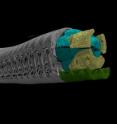Scientists use biomedical technique to image marine worm
Scientists have for the first time successfully imaged the internal tissues of a soft bodied marine worm at high resolution using a technique borrowed from biomedical science. The findings are published in the Journal of Microscopy. "Invertebrate worms are important for the functioning of marine ecosystems, and studies of their internal anatomy are needed to understand their physiology, ecology and evolution," explained John Dinley of the University of Southampton's School of Ocean and Earth Science based at the National Oceanography Centre, Southampton.
"Techniques such as dissection and the cutting of sections for light or electron microscopy studies are time consuming and destructive. What is really needed is a reliable, non-invasive method that can be used in the laboratory," he added.
In conjunction with Professor Ian Sinclair of the University of Southampton's Department of Engineering and other colleagues, Dinley has helped develop the use of a technique called micro-computed x-ray tomography (micro-CT) for scanning the internal structure soft-bodied marine worms.
In micro-CT scanning, the object to be scanned is rotated within a stationary x-ray beam, and magnified images are received onto a detector screen. The researchers have successfully used a bench-top micro-CT scanner to produce high-definition images of the internal structure of the predatory, burrowing worm Nephtys hombergii, specimens of which were collected from the sands of Poole Harbour.
"We believe that this is the first time this technique has been developed and successfully applied to the soft tissues of invertebrates without the use of tissue enhancing stains or radio-opaque fluids," said Dinley.
Impressive three-dimensional rotating and fly-through images have also been produced, which can be invaluable in the assessment of many aspects of functional anatomy.
As a direct result of this work, a micro-CT machine has been installed in the Natural History Museum in London. Now museum specimens or even living specimens can be scanned and their internal organs carefully examined and compared with this rapid, non-invasive and non-destructive technique.
"Large-scale comparative anatomical studies are now feasible that will lead to greater evolutionary insights," says Dinley.
Source: National Oceanography Centre, Southampton (UK)
Other sources
- Oldest Soft-Bodied Marine Fossils Discoveredfrom Live ScienceWed, 19 May 2010, 13:31:07 UTC
- Scientists use biomedical technique to image marine wormfrom Science DailyTue, 18 May 2010, 17:31:36 UTC
- Scientists use biomedical technique to image marine wormfrom PhysorgTue, 18 May 2010, 16:03:26 UTC
- Scientists use biomedical technique to image marine wormfrom Science BlogTue, 18 May 2010, 15:04:50 UTC
